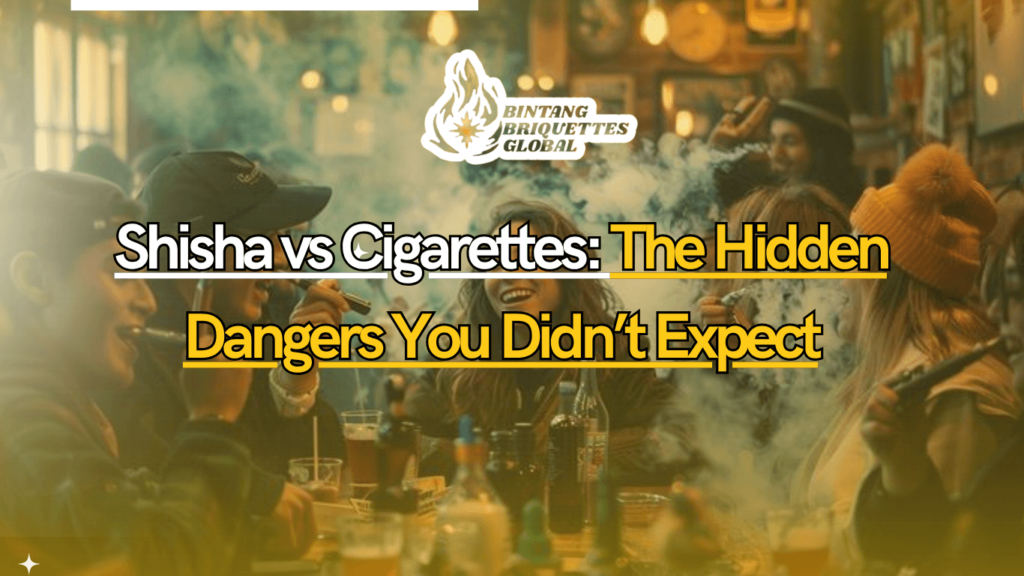I. Introduction
bintangbriquettes.com – In the world of tobacco use, the debate between Shisha vs Cigarettes continues to spark curiosity, concern, and confusion. Shisha, also known as hookah, waterpipe, or narghile, is often viewed as a safer alternative to cigarette smoking, primarily because of its aromatic flavors and social atmosphere. However, growing research suggests that this perception is dangerously misleading. While cigarettes have long been recognized for their health hazards, shisha is still wrapped in layers of cultural tradition, social allure, and pervasive myths.
This article aims to peel back those layers by exploring the hidden dangers behind both smoking methods. We’ll delve into their compositions, how they affect the body, addiction risks, and the psychological and environmental impact. By the end, you’ll have a clearer, evidence-based understanding of which is more harmful and why.
II. The Rise of Shisha and Cigarette Culture
Cigarette Smoking: A Historical Overview Cigarettes became a global commodity in the 20th century, driven by mass production, advertising, and global wars. Their sleek packaging and ease of use made them an instant hit, despite early warnings from medical professionals.
Shisha: Cultural Ritual to Modern Trend Shisha, by contrast, dates back to the 16th century in Persia and India. Traditionally associated with gatherings and hospitality, it is now a popular feature in urban cafes and lounges around the world. Particularly among youth, shisha has evolved into a fashionable lifestyle activity.
Why the Comparison Matters The cultural heritage of shisha often obscures its risks. Unlike cigarettes, which are generally smoked alone and quickly, shisha sessions can last up to an hour, often leading to more smoke inhalation in a single session.
III. Composition Breakdown: What’s Inside?
Cigarettes A cigarette contains shredded tobacco leaves, hundreds of additives, and a filter. When burned, it releases more than 7,000 chemicals, including tar, carbon monoxide, arsenic, and formaldehyde.
Shisha Shisha tobacco (mu‘assel) consists of tobacco leaves mixed with molasses, honey, glycerin, and flavorings. Despite being water-filtered, it still releases harmful toxins like polycyclic aromatic hydrocarbons (PAHs), carbon monoxide, heavy metals, and nicotine.
Water Filtration Myth A common myth is that the water in a shisha pipe filters out harmful substances. However, studies have shown that it filters only a minimal amount, and toxins like carbon monoxide remain largely unaffected.
IV. How the Body Absorbs Smoke
Smoking Patterns Cigarette smokers typically take 10-15 puffs per cigarette over 5 minutes. A shisha session, however, may involve up to 200 puffs over 60 minutes.
Smoke Volume Comparison According to the World Health Organization (WHO), one hour-long shisha session can expose the user to 100 to 200 times the volume of smoke inhaled from a single cigarette.
Health Implications This massive increase in exposure means that shisha users may actually inhale more harmful substances than cigarette smokers in a given session.
V. Health Impact Shisha vs Cigarettes : Short-Term Effects
Cigarettes Short-term effects include increased heart rate, elevated blood pressure, and dizziness. Even occasional use can damage the blood vessels and reduce lung capacity.
Shisha Users often report headaches, nausea, and dizziness due to high carbon monoxide exposure. Sharing the same mouthpiece in lounges can also spread infectious diseases.
Secondhand Smoke Both methods produce secondhand smoke, but shisha lounges often lead to prolonged indoor exposure, affecting both smokers and bystanders.
VI. Long-Term Consequences
Cancer Both cigarettes and shisha are linked to increased risk of lung, oral, esophageal, and bladder cancers. The flavorings in shisha may mask harshness, encouraging deeper inhalation.
Heart Disease Prolonged use leads to higher blood pressure, arterial damage, and eventually heart attacks or strokes.
Lung Function Regular smokers of either form show reduced lung function, chronic bronchitis, and increased susceptibility to infections like pneumonia.
Fertility Issues Smoking disrupts reproductive hormones, affects sperm quality in men, and increases miscarriage risks in women.
VII. Psychological and Social Factors
Social Acceptance Shisha is often seen as a social ritual, making it more acceptable among youth and within families. Cigarettes, in contrast, are often stigmatized.
Stress Relief Myths Many believe smoking either product reduces stress. In reality, nicotine creates a cycle of dependence, where withdrawal feels like stress.
Peer Pressure and Youth Appeal Flavored tobacco, colorful pipes, and relaxed environments make shisha especially appealing to teenagers and young adults.
VIII. Regulatory Landscape and Public Perception
Cigarette Regulation Cigarette advertising, packaging, and sales are heavily regulated worldwide. Health warnings are mandatory in many countries.
Shisha Loopholes Shisha often escapes similar scrutiny. In many places, it’s not taxed like cigarettes, lacks proper labeling, and is not restricted in lounges.
Cultural Defense Because shisha is part of cultural identity in many regions, it often receives leniency from authorities and the public.
IX. Common Myths Debunked
- Myth: Shisha is safer because it’s water-filtered. Fact: It still delivers toxic chemicals and high levels of carbon monoxide.
- Myth: Shisha doesn’t cause addiction. Fact: Shisha contains nicotine, making it highly addictive.
- Myth: Flavored shisha is harmless. Fact: Flavoring masks danger, encouraging deeper, more frequent inhalation.
X. Comparative Studies and Scientific Data
Numerous studies show shisha’s harm:
- WHO report: One shisha session = smoke of 100+ cigarettes
- CDC data: CO levels in shisha users often double those in cigarette smokers
- Longitudinal research: Higher cancer rates among shisha smokers over 10+ years
XI. Addiction Potential and Dependence
Cigarettes Nicotine content is high and leads to rapid dependency. Quitting causes intense withdrawal.
Shisha Though often smoked less frequently, the high smoke volume and nicotine content can create strong dependence with delayed recognition.
Behavioral Addiction Ritualistic aspects of shisha (preparation, social interaction) also contribute to psychological dependence.
XII. The Environmental Footprint
Cigarette Waste Cigarette butts are the most littered item worldwide. They leach toxins into soil and waterways.
Shisha Impact Shisha charcoal emits significant CO2. Disposable hoses and foil add to waste.
Indoor Pollution Indoor shisha smoking dramatically increases fine particle pollution.
XIII. Expert Opinions and Health Organization Warnings
- WHO: Shisha is not a safe alternative to smoking.
- American Lung Association: One session can equal multiple cigarette packs.
- Doctors: Shisha smokers often underestimate their exposure.
XIV. Personal Stories and Testimonials
- Ahmed (26, Jordan): “I never realized I was addicted until I tried to stop.”
- Maria (22, UK): “Shisha felt harmless at first, but I had serious breathing issues after a year.”
- Daniel (30, US): “Quitting shisha was harder than quitting cigarettes.”
XV. Alternatives and Cessation Tools
- Nicotine patches, gum, and inhalers
- Behavioral therapy and counseling
- Support groups and mobile apps
- Mindfulness and relaxation alternatives (e.g., herbal tea, yoga)
XVI. Final Verdict: Which Is More Harmful?
While both forms of smoking are hazardous, shisha often results in greater smoke intake per session, which may amplify long-term harm. The social nature and perceived safety of shisha make it a stealthier health threat than cigarettes.
XVII. Public Health Implications
- Awareness campaigns are needed to inform youth and parents.
- Stricter regulations on shisha lounges, labeling, and sales.
- Community engagement to respect culture while promoting safety.
Conclusion Shisha vs Cigarettes
Despite its cultural roots and social charm, shisha is not a safer Shisha vs Cigarettes. Both carry serious health risks, addiction potential, and long-term consequences. Understanding the full scope of these dangers is essential for individuals, families, and policymakers alike. Awareness, education, and responsible choices can turn the tide against the myths surrounding tobacco use in all its forms.

